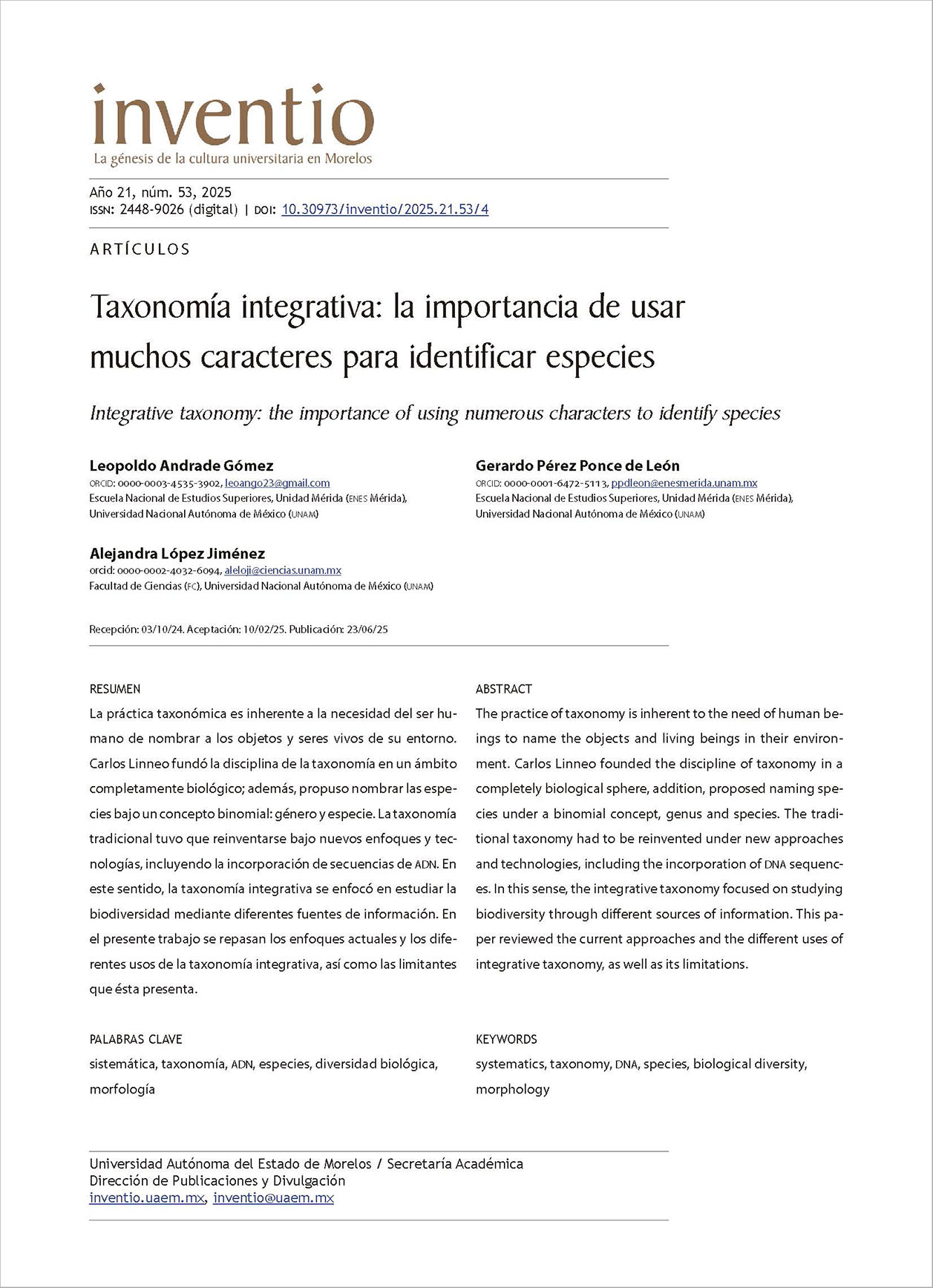Taxonomía integrativa: la importancia de usar muchos caracteres para identificar especies
DOI:
https://doi.org/10.30973/inventio/2025.21.53/4Palabras clave:
sistemática, taxonomía, ADN, especies, diversidad biológica, morfologíaResumen
La práctica taxonómica es inherente a la necesidad del ser humano de nombrar a los objetos y seres vivos de su entorno. Carlos Linneo fundó la disciplina de la taxonomía en un ámbito completamente biológico; además, propuso nombrar las especies bajo un concepto binomial: género y especie. La taxonomía tradicional tuvo que reinventarse bajo nuevos enfoques y tecnologías, incluyendo la incorporación de secuencias de adn. En este sentido, la taxonomía integrativa se enfocó en estudiar la biodiversidad mediante diferentes fuentes de información. En el presente trabajo se repasan los enfoques actuales y los diferentes usos de la taxonomía integrativa, así como las limitantes que ésta presenta.
Citas
Alström, P., Xia, C., Rasmussen, P. C., Olsson, U., Dai, B., Zhao, J., Leader, P. J., Carey, G. J., Dong, L., Cai, T., Holt, P. I., Le Manh, H., Song, G., Liu, Y., Zhang, Y. y Lei, F. (2015). Integrative taxonomy of the russet bush warbler Locustella mandelli complex reveals a new species from central China. Avian Research, 6, 9, 1-33. https://doi.org/10.1186/s40657-015-0016-z
Argue, D., Groves, C. P., Lee, M. S. Y. y Jungers, W. L. (2017). The affinities of Homo floresiensis based on phylogenetic analyses of cranial, dental, and postcranial characters. Journal of Human Evolution, 107, 107-133. https://doi.org/10.1016/j.jhevol.2017.02.006
Avise, J. C. (1993). Kinship and intraspecific phylogeny. En Molecular markers, natural history and evolution (pp. 190-251). Springer. https://books.google.com.mx/books?id=aWSbZf-dRbEC&printsec=frontcover&source=gbs_ge_summary_r&cad=0#v=onepage&q&f=false
Cuvier, F. (1827). L’elephant d’Mrique. En Histoire naturelle des mammifères (pp. 51-52), París, 3(5), 51-52.
Dayrat, B. (2005). Towards integrative taxonomy. Biological Journal of the Linnean Society, 85(3), 407-417. https://doi.org/10.1111/j.1095-8312.2005.00503.x
DeSalle, R., Egan, M. G. y Siddal, M. (2005). The unholy trinity: taxonomy, species delimitation and DNA barcoding. Philosophical Transactions of the Royal Society B, 360, 1905-1916. https://doi.org/10.1098/rstb.2005.1722
De Queiroz, K. (2007). Species concepts and species delimitation. Systematic Biology, 56(6), 879-886. https://doi.org/10.1080/10635150701701083
Desjardin, D. E., Peay, K. G. y Bruns, T. D. (2011). Spongiforma squarepantsii, a new species of gasteroid bolete from Borneo. Mycologia, 103, 1119-1123. https://doi.org/10.3852/10-433
Hunt, G. S. (1996). Description of predominantly arboreal platermaeoid mites from eastern Australia (Acarina: Cryptostigmata: Plateremaeoidea). Records of the Australian Museum, 48, 303-324.
Knapp, S., Lamas, G., Lughadha, E. N. y Novarino, G. (2004). Stability or stasis in the names of organisms: the evolving codes of nomenclature. Philosophical Transactions of the Royal Society of London, 359, 611-622. http://doi.org/10.1098/rstb.2003.1445
Mayr, E. y Ashlock, P. D. (1991). Principles of systematic zoology. McGraw-Hill. https://www.academia.edu/52624751/Principles_of_systematic_zoology_by_Ernst_Mayr
Nicolalde-Morejón, F., Martínez-Domínguez, L., Stevenson D. W. y Vergara-Silva, F. (2019). Disentangling the identity of Zamia from Mexican Pacific seaboard, with a description of a new species. Nordic Journal of Botany, 37(9), 1-9. https://doi.org/10.1111/njb.02430
Padial, J. M., Miralles, A., De la Riva, I. y Vences, M. (2010). The integrative future of taxonomy. Frontiers in Zoology, 7, 2-14. https://doi.org/10.1186/1742-9994-7-16
Pérez-Ponce de León, G., García-Varela, M., Pinacho-Pinacho, C. D., Sereno-Uribe A. L. y Poulin, R. (2016). Species delimitation in trematodes using DNA sequences: Middle-American Clinostomum as a case study. Parasitology, 143(13), 1773-1789. https://doi.org/10.1017/S0031182016001517
Rakotoarison, A., Scherz, M. D., Glaw, F., Köhler, J., Andreone, F., Franzen, M., Glos, J., Hawlitschek, O., Jono, T., Mori, A., Ndriantsoa, S. H., Raminosoa, N. R., Riemann, J. C., Rödel, M.-O., Rosa, G. M., Vieites, D. R., Crottini, A. y Vences, M. (2017). Describing the smaller majority: integrative taxonomy reveals twenty-six new species of tiny microhylid frogs (genus Stumpffia) from Madagascar. Vertebrate Zoology, 67(3), 271-398. https://doi.org/10.3897/vz.67.e31595
Wake, M. H. (2003). What is “integrative biology”? Integrative and Comparative Biology, 43(2), 239-241. https://doi.org/10.1093/icb/43.2.239
Wood, B. (1992). Origin and evolution of the genus Homo. Nature, 355, 783-790. https://doi.org/10.1038/355783a0
Zachos, F. E. (2016). Species concepts in biology. Historical development, theoretical foundations and practical relevance. Springer.

Publicado
Cómo citar
Número
Sección
Licencia
Derechos de autor 2025 Leopoldo Andrade Gómez, Alejandra López Jiménez, Gerardo Pérez Ponce de León

Esta obra está bajo una licencia internacional Creative Commons Atribución-NoComercial 4.0.
Esta revista proporciona acceso abierto inmediato a su contenido, con base en el principio de ofrecer al público un acceso libre a las investigaciones para contribuir a un mayor intercambio global de conocimientos. Se distribuye bajo una licencia Creative Commons Reconocimiento-NoComercial 4.0 Internacional License.

